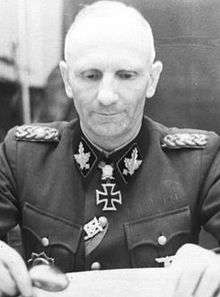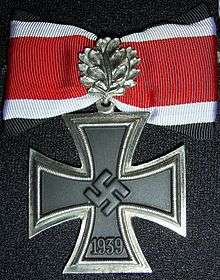Herbert Gille
| Herbert Otto Gille | |
|---|---|
 | |
| Born |
8 March 1897 Gandersheim, German Empire |
| Died |
26 December 1966 (aged 69) Stemmen, West Germany |
| Allegiance |
|
| Service/branch |
Heer (to 1919) |
| Years of service | 1914–19, 1934–45 |
| Rank |
|
| Service number |
NSDAP #537,337 SS #39,854 |
| Commands held | SS Division Wiking |
| Battles/wars |
World War II |
| Awards | Knight's Cross of the Iron Cross with Oak Leaves, Swords and Diamonds |
| Other work | Leading member of HIAG |
Herbert Otto Gille (8 March 1897 – 26 December 1966) was a German member of the Waffen-SS during World War II. He was a recipient of the Knight's Cross of the Iron Cross with Oak Leaves, Swords and Diamonds, making him the most highly decorated Waffen-SS member of the war. After the war, Gille became active in HIAG, a lobby group and a revisionist veteran's organisation founded by former high-ranking Waffen-SS personnel in West Germany in 1951.
World War II
Gille served in World War I and won the Iron Cross First and Second Classes. In 1931 when he joined the Nazi Party and the SS. In 1934 the SS combat support forces. As the commander of a battalion in an SS-V regiment, Gille participated in the invasion of Poland and in the western campaign. In 1940 he was appointed a regimental commander in the SS Division Wiking, led by Felix Steiner.
With his regiment, Gille participated in the Operation Barbarossa in 1941 and in advance to Kuban in 1942; he received the Knight's Cross on 8 October 1942. He then took command of the Wiking Division on the Eastern Front. Early in 1944, Gille participated in the breakout of the Group Stemmermann from the Korsun-Cherkassy Pocket. Gille received the diamonds to his Knight's Cross with Oak Leaves and Swords on 19 April 1944. In January 1945 Gille, as leader of the IV SS Panzer Corps, participated in a failed attempt to relieve the encircled German and Hungarian troops in the Battle of Budapest. In March 1945 he led the IV SS Panzer Corps in the failed Lake Balaton Offensive. He surrendered to the U.S forces in Austria.
Activities within HIAG
Gille was released in 1948. In the early 1950s, Gille became active in HIAG, a lobby group and a revisionist veteran's organisation founded by former high-ranking Waffen-SS personnel in West Germany to campaign for their legal, economic and historical rehabilitation. Gille, alongside Felix Steiner, Otto Kumm and Paul Hausser, became an early leading figure within HIAG. In 1951 Gille launched the periodical Wiking-Ruf ("Viking Call"). Initially it was aimed at the veterans of the SS Division Wiking. Within its first year of existence, in 1952, it became the official publication of HIAG and was eventually renamed to Der Freiwillige ("The Volunteer").[1]
Gille faced his share of controversy with the organisation. In 1952, HIAG held its first major meeting in Verden. It began respectably, with Gille announcing that the veterans were ready to 'do their duty for the Fatherland' and Steiner declaring support for 'freedom, order and justice'. But the next speaker delivered a different message. Former paratroop general Hermann-Bernhard Ramcke, who had been invited to demonstrate so-called solidarity with the Wehrmacht, condemned the Western Allies as the 'real war criminals' and insisted that the blacklist on which all former SS members then stood would soon become "a list of honor".[2] The outburst caused a furor within West Germany. Periodicals as far as the U.S. and Canada carried headlines Hitler's Guard Cheers Ex-chief and Rabble-Rousing General Is Worrying the Allies, with the latter article reporting that Ramcke's speech had been greeted with "roars of approval and cries "Eisenhower, Schweinehund!" ("Pig – Dog")".[3][4]
Internal disagreements began to emerge within HIAG in the mid-1950s as to the stance of the organisation: Steiner and Gille favored a more political, outspoken orientation, while the rest of the leadership favored a moderate approach so that not to jeopardize HIAG's goals of legal and economic rehabilitation, which, in their opinion, could only come from the establishment.[5]
Herbert Gille died in 1966.
Awards
- War Merit Cross Second and First Classes (Brunswick)[6]
- Military Merit Cross 3rd Class with War Decoration (Austria-Hungary)[6]
- German Cross in Gold on 28 February 1942 as SS-Oberführer in SS-Artillerie-Regiment 5[7]
- Knight's Cross of the Iron Cross with Oak Leaves, Swords and Diamonds
- Knight's Cross on 8 October 1942 as commander of SS-Artillerie-Regiment 5 "Wiking"[8]
- 315th Oak Leaves on 1 November 1943 as commander of SS-Panzergrenadier-Division "Wiking"[8]
- 47th Swords on 20 February 1944 as commander of SS-Panzergrenadier-Division "Wiking"[8]
- 12th Diamonds on 19 April 1944 as commander of 5th SS-Panzer-Division "Wiking"[8]
- Finnish Order of the Cross of Liberty 1st Class with Swords[6]
References
Citations
- ↑ Large 1987, p. 93.
- ↑ Large 1987, p. 91.
- ↑ Ottawa Citizen 1952.
- ↑ Sarasota Herald-Tribune 1952.
- ↑ Large 1987.
- 1 2 3 Berger 1999, p. 83.
- ↑ Patzwall & Scherzer 2001, p. 137.
- 1 2 3 4 Scherzer 2007, p. 335.
Bibliography
- Berger, Florian (1999). Mit Eichenlaub und Schwertern. Die höchstdekorierten Soldaten des Zweiten Weltkrieges [With Oak Leaves and Swords. The Highest Decorated Soldiers of the Second World War] (in German). Vienna, Austria: Selbstverlag Florian Berger. ISBN 978-3-9501307-0-6.
- Large, David Clay (1987). "Reckoning without the Past: The HIAG of the Waffen-SS and the Politics of Rehabilitation in the Bonn Republic, 1950–1961". The Journal of Modern History. University of Chicago Press. 59 (1): 79–113. doi:10.1086/243161. JSTOR 1880378.
- Patzwall, Klaus D.; Scherzer, Veit (2001). Das Deutsche Kreuz 1941 – 1945 Geschichte und Inhaber Band II [The German Cross 1941 – 1945 History and Recipients Volume 2] (in German). Norderstedt, Germany: Verlag Klaus D. Patzwall. ISBN 978-3-931533-45-8.
- Scherzer, Veit (2007). Die Ritterkreuzträger 1939–1945 Die Inhaber des Ritterkreuzes des Eisernen Kreuzes 1939 von Heer, Luftwaffe, Kriegsmarine, Waffen-SS, Volkssturm sowie mit Deutschland verbündeter Streitkräfte nach den Unterlagen des Bundesarchives [The Knight's Cross Bearers 1939–1945 The Holders of the Knight's Cross of the Iron Cross 1939 by Army, Air Force, Navy, Waffen-SS, Volkssturm and Allied Forces with Germany According to the Documents of the Federal Archives] (in German). Jena, Germany: Scherzers Miltaer-Verlag. ISBN 978-3-938845-17-2.
- "Rabble-Rousing General Is Worrying the Allies". Ottawa Citizen. 1952. Retrieved 2 December 2015.
- "Hitler's Guard Cheers Ex-chief". Sarasota Herald-Tribune. 1952. Retrieved 2 December 2015.
| Military offices | ||
|---|---|---|
| Preceded by SS-Obergruppenführer Felix Steiner |
Commander of 5. SS-Panzer-Division Wiking 1 May 1943 – 6 August 1944 |
Succeeded by SS-Oberführer Eduard Deisenhofer |
| Preceded by SS-Brigadeführer Nikolaus Heilmann |
Commander of IV. SS-Panzerkorps 6 August 1944 – 8 May 1945 |
Succeeded by dissolved on May 8, 1945 |
